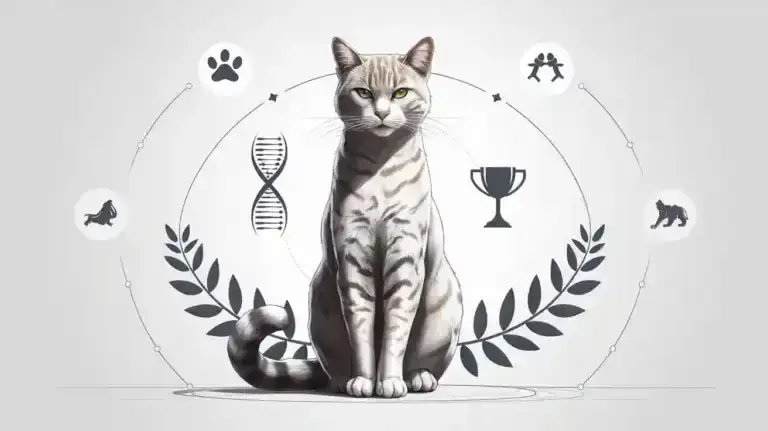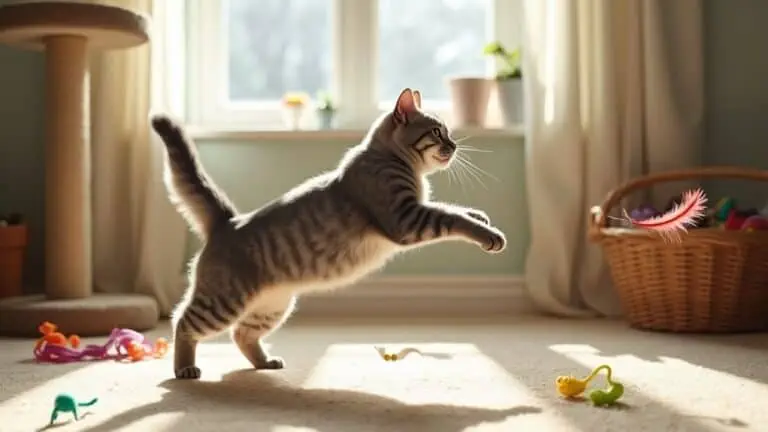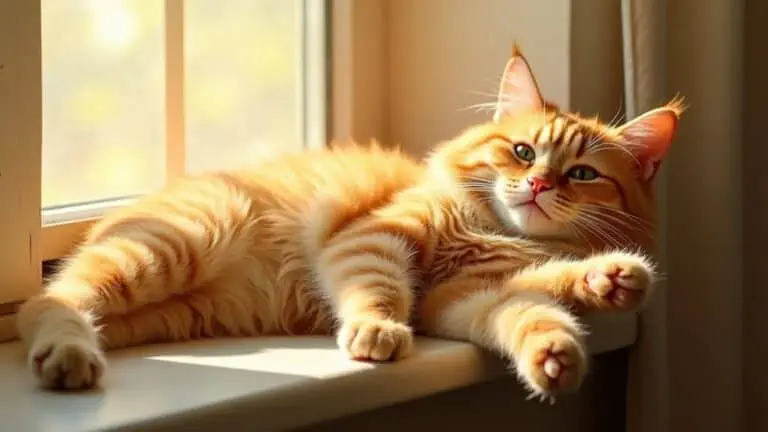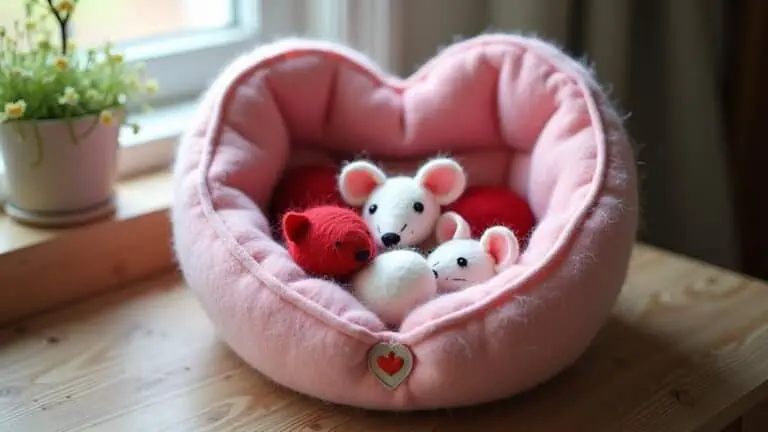The Best Fluffy Pancakes recipe you will fall in love with. Full of tips and tricks to help you make the best pancakes.

Just as Olympic athletes don't let winter weather dampen their training spirits, your indoor cat shouldn't have to put their natural athleticism on pause when the temperature drops. You'll be amazed at how quickly your feline friend can transform from a couch potato to an agile champion with the right indoor activities and setup. Whether you've got a playful kitten or a seasoned senior cat, creating an indoor Olympics experience will keep them physically fit and mentally sharp during those long winter months. Let's explore how to turn your living space into the purr-fect training ground.
Why Indoor Olympics Matter for Your Cat
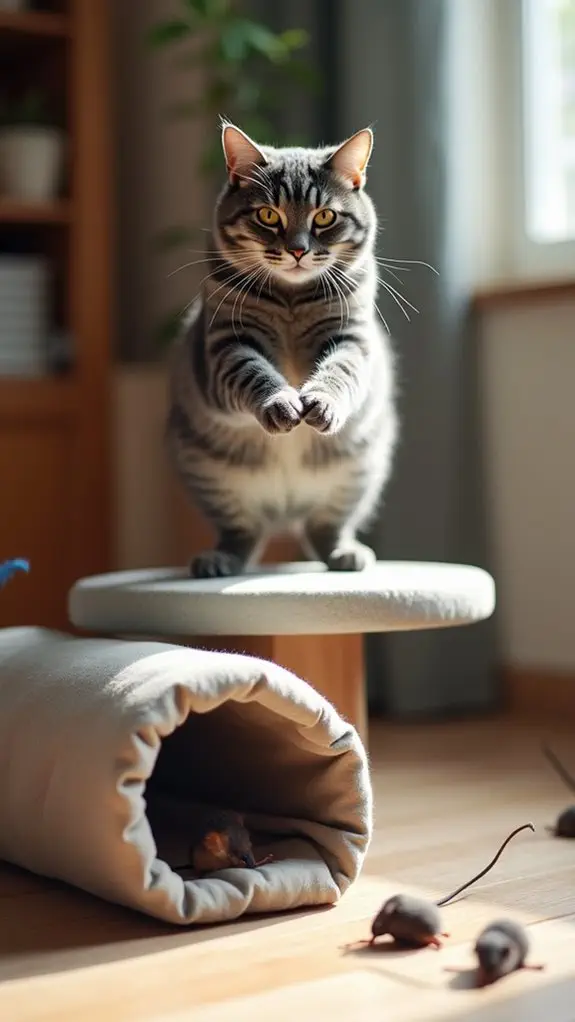
While outdoor cats naturally stay active chasing butterflies and climbing trees, your indoor feline friend needs structured playtime to maintain their physical and mental well-being. Indoor play isn't just about keeping your cat entertained – it's vital for their overall health and happiness.
Regular exercise helps prevent unwanted behavioral problems in indoor cats. Interactive toys provide mental stimulation that is key to fulfilling their natural instincts. When you engage in regular bonding time through play, you're helping satisfy their natural feline instincts while preventing common behavioral issues. Since cats tend to be more inactive in winter, providing structured play becomes even more essential.
During winter months, these indoor Olympics become even more significant as your cat may feel less energetic. By providing mental stimulation through interactive games and exercise, you're not just supporting their physical health – you're also strengthening your special bond.
The health benefits are remarkable: better circulation, maintained weight, and improved digestive health, all while keeping those playful paws moving!
Essential Equipment for Feline Winter Games
Setting up your indoor cat Olympics doesn't require expensive equipment – you'll be amazed at how many household items can transform into perfect feline sporting gear!
Your cat's winter exercise routine can include exciting agility courses using everyday objects you already have at home. Incorporating environmental stimulation through various activities encourages natural behaviors and helps reduce stress.
Remember that positive reinforcement during training sessions helps build confidence and creates a stronger bond with your cat.
Here are three essential categories of equipment you'll need:
- Create tunnels using cardboard boxes, PVC pipes, or pop-up tents
- Set up jumps with broomsticks supported by books or cushions
- Use fishing rod toys and treats as motivational tools for training
Consider incorporating food puzzle toys to add mental challenges to the physical activities.
Your cat agility course can be as simple or complex as you'd like. Transform your living room into a feline fitness center using paper bags for tunnels, chairs for weaving posts, and sturdy tables for jumping platforms.
You'll have a blast watching your furry athlete tackle these winter games!
Setting Up Your Cat's Training Arena
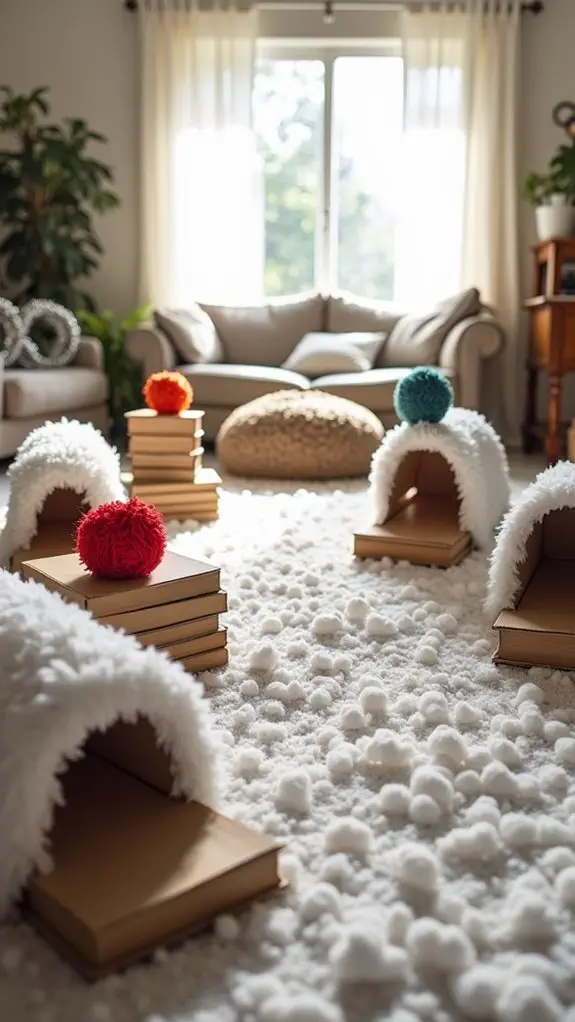
Before you start training your feline athlete, creating the perfect arena will set both you and your cat up for success.
Choose a quiet, well-lit space where you can nurture positive cat behavior without distractions. Just like the progress hat tracks achievements in magical training, you'll want to monitor your cat's development over time. You'll want to lay down a non-slip mat to prevent any tumbles during those enthusiastic training sessions.
Consider incorporating 30 minutes of exercise spread throughout the day to keep your cat engaged and healthy. As you arrange the obstacles, start simple to build your cat's training motivation.
Place tunnels, jumps, and weave poles in a logical sequence, making sure everything's secure and sturdy. You'll guide your furry Olympian through the course using their favorite teaser wand or toy, rewarding them with treats and praise along the way.
Remember to keep an eye on your athlete's energy level and provide breaks – even champion cats need their catnaps!
Designing the Purr-fect Obstacle Course
Once you've prepared your training space, it's time to create an obstacle course that'll challenge and delight your feline friend.
When planning your feline agility course, remember that cats love variety and need safe spaces to explore. Your obstacle design should include a mix of vertical and horizontal challenges, with plenty of room for both you and your cat to move comfortably. Regular grooming can also help keep your cat comfortable during active play, as skin health is important for their overall well-being. We strongly recommend gathering participant feedback to help refine and improve your course design over time. Consider using durable materials like rubber flooring to prevent slipping during training sessions.
Here are three essential elements for your course:
- Start with PVC hurdles and weave poles at varying heights to build confidence.
- Add commercial tunnels and resting platforms to create engaging pathways.
- Include vertical climbing elements with sisal posts and secure shelving.
Remember to gradually increase difficulty as your cat masters each element.
You'll want to fasten everything properly using ZIP ties or PVC glue to guarantee a safe training experience.
Step-by-Step Training Methods

Training your cat to become an indoor Olympian starts with understanding the power of positive reinforcement and consistent practice. You'll want to master your clicker timing to mark desired behaviors instantly, followed by treats and praise to reinforce success. Begin by introducing your cat to a target stick, which you'll use to guide them through basic movements. Start with simple tasks like following the stick to a specific spot or sitting on command. As you engage your cat, remember that gentle handling can contribute significantly to their comfort and willingness to learn. Once they're comfortable, gradually progress to more challenging activities like weaving between poles or jumping over small hurdles. Consider tracking trends in your cat's favorite activities using pattern monitoring to optimize future training sessions. If your cat shows signs of fatigue or disinterest, remember to take regular breaks during training sessions. Don't forget to keep training sessions short and fun!
Safety Tips for Indoor Cat Athletics
Safety stands at the heart of creating an exciting indoor Olympics experience for your feline athlete.
When designing cat fitness activities, you'll want to create a secure environment that encourages natural behaviors while protecting your furry Olympian from potential hazards.
Here are three essential safety tips to enhance your cat's indoor activities:
- Set up stable climbing structures and window perches to satisfy your cat's vertical exploration needs.
- Choose durable, interactive toys that won't create choking hazards, and rotate them regularly to maintain interest.
- Create obstacle courses using safe household items like boxes and cushions, ensuring all elements are secure.
Regular grooming not only ensures comfort during play but also aids in early detection of health issues, contributing to your cat's overall well-being.
Remember to supervise your cat's playtime and remove any sharp objects from the area.
Making Exercise Fun and Rewarding
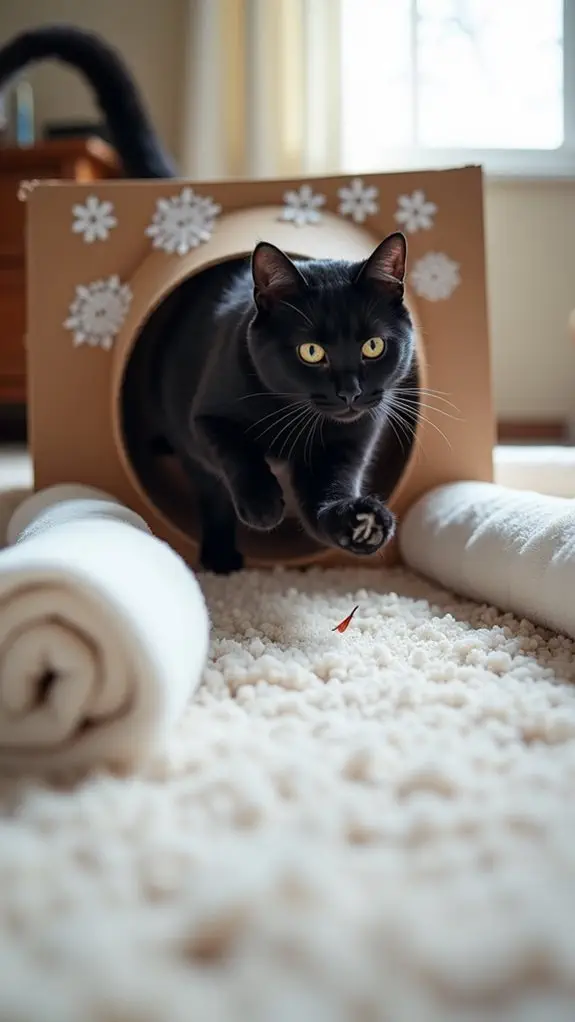
You'll find that combining treats with exercise creates an irresistible workout experience for your cat.
Try placing small treats at different points along your homemade obstacle course, or use them as rewards after your cat completes a challenging play session with their favorite toys.
When you transform exercise into a rewarding game, you'll notice your cat's enthusiasm for physical activity skyrocket, making it easier to maintain regular workout routines. Additionally, incorporating interactive play into your routine can further enhance your cat's engagement and excitement during exercise.
Treat-Based Training Games
Playtime with your feline friend becomes an exciting adventure when treats enter the equation. With proper treat selection and training consistency, you'll transform everyday activities into engaging games that keep your cat mentally and physically active.
Get started with these tried-and-true training games:
- Hide small treats throughout your home, encouraging your cat to "hunt" for their rewards while getting exercise.
- Use a target stick with a treat reward to guide your cat through an obstacle course you've created.
- Practice "come when called" by offering a high-value treat each time your cat responds to their name.
Remember to keep sessions short and fun, using your cat's favorite healthy treats as motivation. Regular play supports physical development for your cat, helping maintain healthy joints and muscles.
You'll be amazed at how quickly your furry athlete picks up new skills while strengthening your special bond together.
Reward Through Play Sessions
Beyond treat-based training, engaging play sessions serve as powerful rewards that tap into your cat's natural instincts.
You'll discover countless playtime benefits as you transform your home into an exciting indoor enrichment zone using interactive toys like feather wands and motorized mice.
Create an obstacle course with cardboard boxes and tunnels, encouraging your furry friend to jump, climb, and explore their environment.
Don't forget to mix mental stimulation with physical activity.
Set up food puzzles, organize hide-and-seek games with toys, or create a cozy window perch for "bird TV" entertainment.
By rotating toys and varying activities, you'll keep your cat engaged while strengthening your bond.
Remember to supervise all play sessions and celebrate your cat's achievements with gentle praise and affection. Additionally, these interactive experiences cater to your cat's natural hunting instincts, promoting both exercise and mental engagement.
Tracking Your Cat's Progress
To make your cat's indoor Olympics experience more meaningful, you'll want to keep track of personal records and daily achievements using simple activity log charts.
Setting specific goals, like completing an obstacle course in under 30 seconds or increasing playtime duration by five minutes each week, helps you measure your cat's progress and celebrate their wins.
You can make tracking fun by creating a special "medals board" where you'll post your cat's accomplishments, from "fastest laser pointer chase" to "highest vertical jump." Additionally, incorporating engaging toys into your training sessions can enhance your cat's activity and motivation.
Recording Personal Best Times
Just as professional athletes track their performance metrics, keeping detailed records of your cat's indoor Olympics achievements helps create a meaningful training journey.
When tracking your kitty's personal bests, use a digital timer and maintain a consistent course layout to guarantee accurate performance tracking. You'll be amazed at how your furry athlete progresses over time!
Here's how to record your cat's achievements effectively:
- Create a dedicated spreadsheet with separate columns for different obstacles and overall completion times.
- Take quick video recordings to analyze your cat's technique and identify areas for improvement.
- Track multiple trials per session, noting any environmental factors that might affect performance.
Remember to celebrate each milestone with your feline Olympian – those improved times deserve special recognition and maybe an extra treat! Additionally, be attentive to your cat's behavior, as changes in behavior may provide insight into their health and well-being.
Goal Setting With Metrics
While tracking personal bests creates excitement, setting structured goals with measurable metrics takes your cat's indoor Olympics training to the next level.
Start by establishing clear, achievable goals that align with your cat's abilities and interests. You'll want to break down these objectives into smaller success milestones, making the journey more manageable for your furry athlete.
Keep a simple tracking system – whether it's a notebook or spreadsheet – to monitor your cat's progress. Record completion times, successful jumps, and how often they're participating in training sessions.
This data will help you understand what's working and where there's room for improvement. Remember, goal alignment should match your cat's personality and physical capabilities.
If your usually lazy tabby isn't ready for the high jump, start with something more basic and work your way up!
Daily Activity Log Charts
Recording your cat's Olympic journey requires a systematic approach, and daily activity log charts are the perfect tool for the job. The daily log benefits go beyond just tracking progress – they'll help you monitor your furry athlete's health and well-being throughout their training.
For the best health tracking results, make sure to include:
- Feeding and water intake times to maintain ideal energy levels
- Activity duration and intensity during training sessions
- Rest periods and recovery observations
You can choose between digital apps or traditional paper charts to log your cat's progress.
Either way, you'll be amazed at how these simple records help you spot patterns, adjust training intensity, and celebrate improvements.
Plus, if your vet needs information about your cat's routine, you'll have detailed data right at your fingertips!
Common Challenges and Solutions
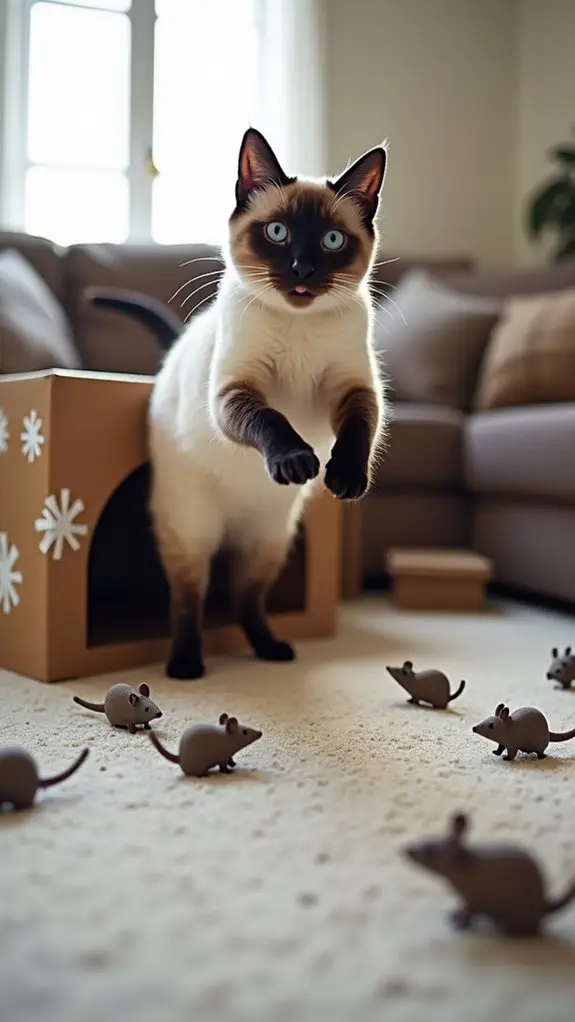
Creating an indoor Olympics for your cat can present several common challenges, but don't worry – they're all manageable with the right approach. Understanding cat behavior and implementing effective training techniques will help you overcome these hurdles with ease.
When you notice your kitty losing interest, try switching up toys and rewards to reignite their motivation. If your cat shows signs of fear, take it slow and create a comfortable environment where they'll feel safe to explore.
For cats struggling with obstacles, start simple and use teaser wands to guide them through the course. Remember, consistency is key – keep your training sessions short, regular, and packed with positive reinforcement.
You'll be amazed at how quickly your feline athlete progresses when you maintain patience and celebrate their small victories along the way.
Taking Your Cat's Skills to the Next Level
Once your cat's mastered the basics, you'll want to step up their game with more challenging obstacle combinations and elevated course designs.
You can create intricate patterns by connecting tunnels to weave poles and adding raised hoops, but remember to keep rewarding your feline athlete with treats and praise as they tackle these tougher challenges.
As your cat's confidence grows, you'll notice they're ready for longer sequences and more complex moves, like combining ramps with quick direction changes or introducing timed elements to their routine.
Advanced Course Design Tips
While basic cat agility courses provide a solid foundation, taking your feline athlete to the next level requires careful attention to advanced course design principles.
When crafting your advanced course, remember that obstacle customization and handler communication are key to success.
For best results, follow these essential guidelines:
- Set up your course in a non-circular pattern to maximize your cat's physical abilities and strengthen your bond through varied movements.
- Space obstacles strategically to maintain flow while challenging your cat's agility.
- Include a mix of high jumps, tight turns, and technical elements that showcase your cat's skills.
Remember to adapt the course based on your cat's fitness level and always prioritize safety.
You'll be amazed at how quickly your furry friend masters these advanced challenges with proper guidance and encouragement.
Mastering Complex Agility Moves
Now that your cat has mastered the basics of agility courses, it's time to explore more challenging moves that'll truly showcase their athletic abilities.
These advanced feline fitness techniques will help your furry athlete reach new heights – literally!
Start by perfecting tunnel runs, using treats and clicker training to build confidence. As your cat becomes more skilled, introduce elevated ramps and higher hurdles.
You'll love watching them gracefully weave through poles with increasing speed and precision. Remember to reward their progress generously!
Ready to take their agility techniques to the next level?
Begin combining obstacles into exciting sequences. Your cat will thrill at the challenge of conquering multiple hurdles, weaving through poles, and zooming through tunnels in one fluid motion.
Before you know it, you'll have a four-legged Olympian on your hands!
Progressive Training With Rewards
Taking your cat's skills to the next level requires a smart approach to rewards and positive reinforcement.
By incorporating reward variety and consistent behavior tracking, you'll help your feline friend master new challenges while having fun together.
Follow these key steps to maximize your training success:
- Reward desired behaviors within 3 seconds to help your cat make the connection.
- Mix up treats, catnip, and playtime as rewards to keep motivation high.
- Gradually shift from constant rewards to intermittent ones as skills improve.
Final Thoughts
Your cat's indoor winter training journey can be as thrilling as a gold medal performance at the Olympics. You'll see your feline friend transform from a couch potato into an agile athlete, mastering new challenges and building confidence with every leap and bound. By keeping up with these engaging activities, you're not just fighting winter blues – you're creating a stronger bond and a healthier lifestyle for your furry champion.

